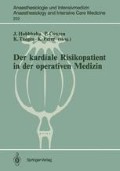Zusammenfassung
Der Einfluß der koronaren Herzkrankheit (KHK) auf die perioperative Morbidität und Mortalität ist von grundlegender Bedeutung.
Access this chapter
Tax calculation will be finalised at checkout
Purchases are for personal use only
Preview
Unable to display preview. Download preview PDF.
Literatur
Abel MD, Nishimura RA, Callahan MJ, Rehder K, Ilstrup DM, Tajik AJ (1987) Evaluation of intraoperative transesophageal two-dimensional echocardiography. Anesthesiology 66: 64
Arbeit SR, Rubin IL, Gross H (1970) Dangers in interpreting the ECG from the oscilloscope monitor. JAMA 211: 453
Blackburn H (1967) The exercise electrocardiogram: Technical, procedural, and conceptional developments. In: Blackburn H (ed) Measurements and exercise electrocardiography. Thomas, Springfield.
Chaitman BR, Bourassa MG, Wagniart P, Corbara F, Ferguson RJ (1978) Improved efficiency of treadmill exercise testing using a multiple lead ECG system and basic hemodynamic exercise response. Circulation 57: 71
Cheng DCH, Chung F, Burns RJ, Houston PL, Feindel CM (1989) Postoperative myocardial infarction documented by technetium pyrophosphate scan using single-photon emission computed tomography: Significance of intraoperative myocardial ischemia and hemodynamic control. Anesthesiology 71: 818–826
Daele MERM van, Sutherland GR, Mitchell MM, Fraser AG, Prakash O, Rulf EN, Roelandt JRTC (1990) Do changes in pulmonary capillary wedge pressure reflect Myocardial ischemia during anesthesia? Circulation 81: 865
Ellis JE, Roizen MF, Aronson S et al. (1988) Comparison of two automated ST-segment analysis systems, EKG (including T wave inversion analysis), and transesophageal echocardiography for the diagnosis of intraoperative myocardial ischemia. Anesthesiology V 69/3A
Häggmark S, Hohner P, Östman M, Friedman A, Diamond G, Lowenstein E, Reiz S (1989) Comparison of hemodynamic, electrocardiographic, mechanical and metabolic indicators of intraoperative myocardial ischemia in vascular surgical patients with coronary artery disease. Anesthesiology 70: 19–25
Knight AA, Hollenberg M, London MJ, Verrier ED, Browner W, Mangano DT and the SPI Research Group (1988) Perioperative myocardial ischemia: Importance of the preoperative ischemic pattern. Anesthesiology 68: 81–688
Kotrly KJ, Kotter GS, Mortara D, Kampine JP (1984) Intraoperative detection of myocardial ischemia with an ST segment trend monitoring system. Anesth Analg 63: 343
Kotter GS, Kotrly KJ, Kalbfleisch JH, Vucins EJ, Kampine JP (1987) Myocardial ischemia during cardiovascular surgery as detected by an ST segment trend monitoring system. J Cardiothorac Anesth 1: 190
Leung JM, O’Kelly B, Browner WS, Tubau J, Hollenberg M, Mangano DT, the SPI Research Group (1989) Prognostic importance of postbypass regional wall-motion abnormalities in patients undergoing coronary artery bypass graft surgery. Anesthesiology 71: 16
London MJ, Hollengerg M, Wong MG, Levenson L, Tubau J, Browner W, Mangano DT, and the SPI Research Group (1988) Intraoperative myocardial ischemia: Localization by continuous 12-lead electrocardiography. Anesthesiology 69: 232–241
Lowenstein E (1985) Perioperative ischemic episodes cause myocardial infarction in humans — A hypothesis confirmed. Anesthesiology 62: 103
Mangano DT (1980) Monitoring pulmonary arterial pressure in coronary artery disease. Anesthesiology 53: 364
Rahimtoola SH, Loeb HS, Ehsani A et al. (1972) Relationship of pulmonary artery to left ventricular diatolic pressures in acute myocardial infarction. Circulation 46: 283–290
Reiz S (1989) Diagnosis, causes and treatment of myocardial ischemia in the operating room. In: Reinhart K, Eyrich K (eds) Clinical aspects of 02-transport and tissue oxygenation. Berlin Heidelberg New York Tokyo
Slogoff S, Keats AS (1988) Does chronic treatment with calcium entry blocking drugs reduce perioperative myocardial ischemia? Anesthesiology 68: 676–680
Slogoff S, Keats AS (1985) Does perioperative myocardial ischemia lead to postoperative myocardial infarction? Anesthesiology 62: 107–114
Slogoff S, Keats AS (1986) Further observations on perioperative myocardial ischemia. Anesthesiology 65: 539–542
Smith JS, Calahan MK, Benefiel DJ et al. (1985) Intraoperative detection of myocardial ischemia in high-risk patients: electrocardiography vs. two-dimensional transesophageal echocardiography. Circulation 72: 1015
Editor information
Editors and Affiliations
Rights and permissions
Copyright information
© 1992 Springer-Verlag Berlin Heidelberg
About this chapter
Cite this chapter
Probst, S. (1992). Monitoring myokardialer Ischämien: Immer noch ein ungelöstes Problem?. In: Hobbhahn, J., Conzen, P., Peter, K., Taeger, K. (eds) Der kardiale Risikopatient in der operativen Medizin. Anaesthesiologie und Intensivmedizin / Anaesthesiology and Intensive Care Medicine, vol 222. Springer, Berlin, Heidelberg. https://doi.org/10.1007/978-3-642-77007-4_8
Download citation
DOI: https://doi.org/10.1007/978-3-642-77007-4_8
Publisher Name: Springer, Berlin, Heidelberg
Print ISBN: 978-3-540-54647-4
Online ISBN: 978-3-642-77007-4
eBook Packages: Springer Book Archive

